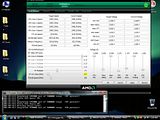OK so this is just very brief. Built the system today, using the Asus board (M3A32-MVP Deluxe), 2 sticks of DDR2-800 CL5, and a 3870 card. Booted to 2.6 Ghz, stock voltage, no problems was able to run several benchmarks (Cinbench R9.5 and R10, no lockups), ran Everest stability (CPU+FPU+Cache) for about 15 mintutes. Could boot to 2.7 GHz but could not run some benches completely, R9.5 completed but R10 did not.
I have not attempted to stress test for stability at this clock yet, so don't get too excited at 2.6

... it is late, I will be posting CPUID shots, and validations in the next few days.
EDIT: Oh, yeah... using cruddy cooler, the AMD stock cooler that came with CPU and the pre-applied TIM. So 2.7 is almost certain, 2.8 likely (I hope). Oh yeah, BIOS is 503 -- dated 11/12/07. Asus did not implement TLB patch until 701 from what I understand.







 Reply With Quote
Reply With Quote

 )
) 









 )
)







Bookmarks